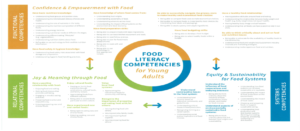This post provides you with a report on the ‘Last Night’s Dinner Project’ I developed for my Year 7 students when we worked and learnt from home during March to June, 2020 during the height of the pandemic.
Background information
I teach 88 Year 7 students (12-13 year olds) from a diverse range of multi-cultural backgrounds at an independent girls K1-12 school in the bayside suburbs of Melbourne.
The aim of our weekly cooking program taken over one semester of 16 weeks is to develop the practical meal making skills that young people need to know to live healthy and independent lives. These essential food skills have been identified in my 2011 journal article (Identification of Essential Food Skills for Skill-Based Healthful Eating Programs in Secondary Schools – you can access the document here Fordyce_Voorham_FoodSkills_2010
By the end of the semester students have a repertoire of twelve standard recipes many of them plant-based – Spaghetti Bolognese, Asian style-stir fry, Risottos, healthy snacks such as stuffed potato and bread-based mini quiches.
Covid19
Required a new solution so that students could still develop these skills but this time at home with their families during lock-down.
Using the Food Literacies competencies framework developed by Canadian academic Joyce Slater (access the article here Slater_et_al-2018-International_Journal_of_Consumer_Studies , I wanted to focus not only on the ‘hands-on’ skills but take the opportunity to focus on the ‘Confidence and Empowerment with food’ and the ‘Joy and meaning of food’ and use these as a foundation for the ‘Last Night’s Dinner Project’ .

A Food Literacy Model
The Project
Required each student to nominate a week when they would select and cook an evening meal of their choice for themselves and their families. They needed to justify their meal choice and provide background such as family recipe or cultural themed meal.
Students used an hedonic rating to self-evaluate the sensory properties of the meal and also invited family members to provide them with constructive and positive feedback. (Joy and meaning of food)
The students were trained how to use ADOBE Spark (a video making program) to record or take still photos of themselves making the meal. This video was then shown to their class colleagues during their regular lesson via MS Teams, who also provided positive feedback after viewing the video – this was often a springboard that stimulated further discussion
Results/Conclusion
Students reported that they cooked more and that they wanted to continue to make meal making a weekly event, particularly with the positive feedback from family members.
In the Virtual Poster below, I really liked how (student) mentioned that the task allowed her to take risks – empowerment and confidence with food.
Digital technologies were also enhanced as the students learnt new ways of presenting information other than static Power Point presentations.